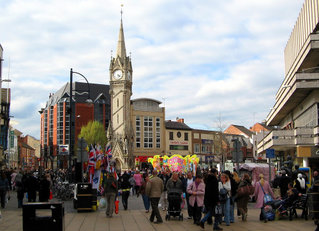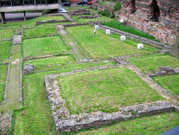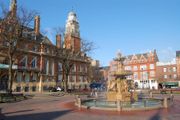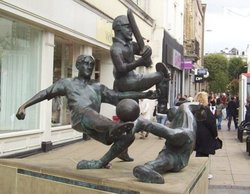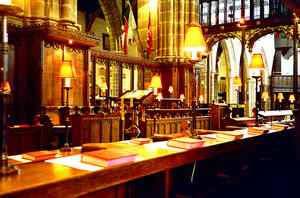Leicester
2007 Schools Wikipedia Selection. Related subjects: Geography of Great Britain
Leicester ( pronounced [ˈlɛstə]) is the largest city in the East Midlands of England. It is the traditional county town of Leicestershire, and, since 1997, has been a self-governing unitary authority. It lies on the River Soar and at the edge of the English National Forest. In 2004, the population of the city proper was estimated at 285,100, with 441,213 living in the urban area. It is currently, by population, the 10th largest city in England and the 13th largest in the UK. It is also the 97th largest in Europe.
The urban area extends beyond the boundaries of the city proper to include the satellite towns of Oadby, Wigston, Braunstone Town, Birstall, Glenfield, Blaby, Thurmaston, Syston and Leicester Forest East. A number of these towns are in fact closely integrated suburbs of the city itself, especially Glenfield and Braunstone. For areas within the city, see Areas of Leicester. In terms of population within the city limits it is the largest in the East Midlands.
Leicester is one of the oldest cities in England, having been founded by the Romans.
General information
| City of Leicester | |
|---|---|
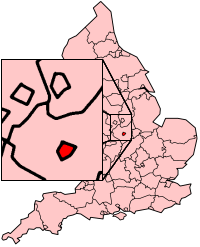 |
|
| Geography | |
| Status: | Unitary, City (1919) |
| Region: | East Midlands |
| Ceremonial County: | Leicestershire |
| Area: - Total |
Ranked 276th 73.32 km² |
| Admin. HQ: | Leicester |
| Latitude | 52°38'06"N |
| Longitude | 1°08'06"W |
| Grid reference: | SK 5804 |
| ONS code: | 00FN |
| Demographics | |
| Population: - Total (2005 est.) - Density |
Ranked 20th 288,000 3,928 / km² |
| Ethnicity: | 63.9% White 29.9% S.Asian 3.1% Afro-Carib 2.3% Mixed 0.8% Chinese. |
| Politics | |
| Leicester City Council http://www.leicester.gov.uk/ |
|
| Leadership: | Leader & Cabinet |
| Executive: | Liberal Democrats / Conservative |
| MPs: | Patricia Hewitt, Peter Soulsby, Keith Vaz |
The city is next to the M1 motorway, and is on the Midland Main Line from London to Sheffield, Nottingham and Leeds. High-speed trains operated by Midland Mainline can reach London in just over an hour. It is also served by rail lines to Birmingham via Nuneaton, and to Peterborough.
Major industries in Leicester today include food processing, hosiery, footwear, knitwear, engineering, electronics, printing and plastics.
The city centre is mainly Victorian with some later developments, which have usually been integrated in smoothly. The heart of the city centre is the Clock Tower, which is at the intersection of five routes into the city - High Street, Churchgate, Belgrave Gate, Humberstone Gate, and Gallowtree Gate. Today, the latter two are pedestrianised, and vehicles are restricted on the others.
Leicester City Centre is home to the Haymarket and the Shires shopping centres, both of which face the clock tower. Leicester Market, Europe's largest covered market, is nearby. The historic core of the City lies slightly to the west, and monuments here include the Castle, the Anglican cathedral of St Martin, the medieval churches of St Mary de Castro and St. Nicholas, the Guildhall and the Jewry Wall.
It is set to become a major city with many developments on the horizon implemented by the Leicester Regeneration Company including the £51 million Leicester Performing Arts Centre designed by Rafael Viñoly.
In 1990, Leicester was designated the UK's first Environment City, and won the European Sustainable City Award in 1996.
Leicester has a large ethnic minority population, mainly from the Indian subcontinent. There are many Hindu mandirs, Sikh gurdwaras and Muslim mosques around the city, mostly converted from existing buildings. The Jain Temple in Leicester is near the city centre ( The Jain Centre). The area around Belgrave Road is known as the Golden Mile, and contains many Indian restaurants, jewellery shops, and other shops catering to the large Asian community in the neighbourhood. Many people travel to the area specifically for the restaurants, which serve authentic Indian cuisine. The annual Diwali celebrations are also held here and at the nearby Abbey Park, and are the biggest outside of India. There are also many of Afro-Caribbean descent (mainly from Antigua & Barbuda, Montserrat and Jamaica), the community being centred around Highfields to the southeast of the city centre, and Leicester plays host to the second-largest Caribbean Carnival in the UK after Notting Hill. While some wards in the North-East of the city are more than 70% Asian, wards in the West and South are all over 70% White. The city is set to become the first major urban area in the UK with a non-white ethnic majority population, by the time of the next census in 2011.
History
According to Geoffrey of Monmouth, the mythical king of the Britons King Leir founded the city of Kaerleir (Leicester). He was supposedly buried by Queen Cordelia in a chamber beneath the River Soar near the city dedicated to the Roman god Janus, and every year people celebrated his feast-day near Leir's tomb. William Shakespeare's King Lear is loosely based on this story.
Roman
Leicester is one of the oldest cities in England, with a history going back nearly 2000 years. The Roman city of Ratae Coritanorum was founded in AD 50 as a military settlement upon the Fosse Way Roman road. The city was named after the Corieltauvi, the Celtic tribe that dwelt in the area before the Romans arrived.
Ratae Coritanorum grew into an important trading and military centre and one of the largest towns in Roman Britain. The remains of the baths of Roman Leicester can be seen at the Jewry Wall, and other Roman artefacts are displayed in the Jewry Wall museum adjacent to the site.
Christian martyrdoms?
According to the Venerable Bede, Roman Leicester may have been the site of several early Christian Martyrdoms in Britain, at the same time as that of St. Alban the first English martyr, who was killed in the Roman city of Verulamium (beside modern-day St Albans. He writes:
- Passi sunt ea tempestate Aaron et Iulius Legionum urbis ciues, aliique utriusque sexus diuersis in locis perplures, qui diuersis cruciatibus torti, et inaudita membrorum discerptione lacerati, animas ad supernae ciuitatis gaudia perfecto agone miserunt.
- "At the same time suffered Aaron and Julius, inhabitants of the city of the legions, and many others of both sexes, in other places; who, having been tormented on the rack till their members were dislocated, and having endured various other unheard-of cruelties, yielded their souls, after the conflict was over, to the joys of the city above." - Historia ecclesiastica gentis Anglorum. Book One, Chapter Seven
This 'city of the legions' may be identified with Chester, Caerleon, or Leicester.
Saxon and Viking
The Roman town was largely abandoned when the Romans left Britain in the 5th century, but was later re-settled by Saxons. In the 9th century, Leicester was captured by the Danes (Vikings) and became one of the five boroughs (fortified towns) of Danelaw, although this position was short lived. The Saxon Bishop of Leicester fled to Dorchester-on-Thames and Leicester was not to become a bishopric again until the twentieth century.
It is believed the name "Leicester" is derived from the words castra (camp) of the Ligore, meaning dwellers on the 'River Legro' (an early name for the River Soar). In the early tenth century it was recorded as Ligeraceaster = "the town of the Ligor people". The Domesday book later recorded it as Ledecestre.
Medieval
Leicester had become a town of considerable importance by Medieval times. It was mentioned in the Domesday Book as 'civitas' (city), but Leicester lost its city status in the eleventh century owing to power struggles between the Church and the aristocracy. It was eventually re-made a city in 1919, and the Church of St Martin became Leicester Cathedral in 1927. The tomb of King Richard III is located in the central nave of the church although, according to local tradition, he is not actually buried there. He was originally buried in the Greyfriars Church in Leicester, but his corpse was exhumed under orders from Henry VII and cast into the River Soar.
Leicester played a significant role in the history of England, when, in 1265, Simon de Montfort forced King Henry III to hold the first parliament of England at the now-ruined Leicester Castle.
Tudor
On 4 November 1530, Thomas Cardinal Wolsey was arrested on charges of treason and taken from York Palace. On his way south to face dubious justice at the Tower of London, he fell ill. The group escorting him were concerned enough to stop at Leicester. There, Wolsey's condition quickly worsened and he died on 29 November 1530 and was buried at Leicester Abbey, now Abbey Park.
18th and 19th centuries
With the construction of the Grand Union Canal in the 1790s linking Leicester to London and Birmingham, Leicester began rapid industrialisation. The main industries being hosiery, footwear and, especially in the twentieth century, engineering. All are, however, in decline now.
By 1832, railways had arrived in Leicester with the opening of the Leicester and Swannington Railway, which provided a supply of coal to the town from nearby collieries. By 1840 the Midland Counties Railway had linked Leicester to the national railway network, which further boosted industrial growth. By the 1860s Leicester had gained a direct rail link to London ( St Pancras) with the completion of the Midland Main Line. The Great Central Railway arrived in 1900, providing an alternative route to London. However, this closed in 1966.
The borough expanded throughout the nineteenth century, most notably in 1892 annexing Belgrave, Aylestone, Knighton and North Evington. The city obtained its current boundaries in 1935, with the annexation of the remainder of Evington, Humberstone, Beaumont Leys, along with part of Braunstone. It became a county borough when these were established in 1889, but, as with all county boroughs, was abolished by the Local Government Act 1972 in 1974, becoming an ordinary district of Leicestershire. It regained its unitary status in 1997.
Post WWII
In the decades after World War II, Leicester gained a large population of immigrants from the Indian sub-continent, and from Kenya and Uganda in the early 1970s. These immigrant groups make up around 40% of Leicester's population, making Leicester one of the most ethnically diverse cities in the United Kingdom. Among the more recent arrivals are a group of Dutch citizens of Somali origin, apparently drawn by its free and easy atmosphere and by the number of mosques. In the UK, Leicester today is widely regarded as a model of inter-communal tolerance; however, for a short period in the 1970s, the neo-fascist National Front recorded high votes in the city. Leicester is expected by 2011 to become the first major city in Britain in which the ethnic minority population will form a majority.
Coat of Arms
The Corporation of Leicester's coat of arms was first granted to the city at the Heraldic Visitation of 1619, and is based on the arms of the first Earl of Leicester, Robert Beaumont. The field is a white cinquefoil on a red background, and this emblem is used by the City Council.
After Leicester became a city in 1919, the city council applied to add to the arms, permission for which was granted in 1929, when the supporting lions, from the Lancastrian Earls of Leicester, were added.
The motto "Semper Eadem" was the Motto of Queen Elizabeth I, who granted a royal charter to the city. It means "Always the same". The crest on top of the arms is a white or silver legless wyvern with red and white wounds showing, on a wreath of red and white. The supporting Lions are wearing coronets in the form of collars, with the white cinquefoil hanging from them.
Economy
This is a chart of trend of regional gross value added of Leicester at current basic prices published (pp.240-253) by Office for National Statistics with figures in millions of British Pounds Sterling.
| Year | Regional Gross Value Added | Agriculture | Industry | Services |
|---|---|---|---|---|
| 1995 | 3,561 | 1 | 1,256 | 2,304 |
| 2000 | 4,513 | - | 1,425 | 3,088 |
| 2003 | 5,087 | 1 | 1,289 | 3,797 |
- ^ Components may not sum to totals due to rounding
- ^ includes hunting and forestry
- ^ includes energy and construction
- ^ includes financial intermediation services indirectly measured
Politics
On April 1, 1997, Leicester City Council became a unitary authority, local government up until then having been a two-tier system with the city and county councils being responsible for different aspects of local government services (a system which is still in place in the rest of Leicestershire). Leicestershire County Council retained its headquarters at County Hall in Glenfield, just outside the city boundary but within the urban area. The administrative offices of Leicester City Council are in the centre of the city at the New Walk Centre and other office buildings near Welford Place. Some services (particularly the police and the ambulance service) still cover the whole of the city and county, but for the most part the two councils are independent.
After a long period of Labour administration (since 1979), the city council from May 2003 was run by a Liberal Democrat/ Conservative coalition under Roger Blackmore, which collapsed in November 2004. The minority Labour group ran the city until May 2005, under Ross Willmott, when the Liberal Democrats and Conservatives formed a new coalition, again under the leadership of Roger Blackmore.
Leicester is divided into three Parliamentary constituencies. Leicester East and Leicester West are represented by Keith Vaz and Patricia Hewitt respectively - both members of the Labour Party. The third seat, Leicester South, became vacant in May 2004 on the death of Labour politician Jim Marshall. A by-election was held on July 15, and was won by Parmjit Singh Gill of the Liberal Democrats, with a 21% swing. This by-election saw almost 4,000 votes go to a Respect party candidate, who opposed the Iraq war. However, in the 2005 general election, Labour's unsuccessful byelection candidate and former Council leader Sir Peter Soulsby won Leicester South back for the party, and Vaz and Hewitt retained their seats.
Transport
Railway
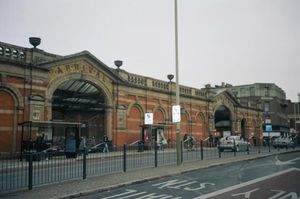 Leicester station is just east of the city centre, on the A6 road.
Leicester station is just east of the city centre, on the A6 road.
Rail routes run north-south through Leicester, going south to London St Pancras and north to Nottingham station and beyond (this route being called the Midland Main Line). There are four platforms at Leicester. Junctions north and south of the city connect to other lines. Train operators using the station include Midland Mainline, and Central Trains.
Education
Leicester is home to two universities, the University of Leicester ( Royal Charter 1957) and De Montfort University (founded in 1992 from Leicester Polytechnic).
It is also home to the National Space Centre, due in part to the University of Leicester being one of the few universities in the UK to specialise in space sciences.
Leicester City Local Education Authority initially had a troubled history when formed in 1997 as part of the local government reorganisation - a 1999 Ofsted inspection found "few strengths and many weaknesses", although there has been considerable improvement since then. While many state schools provide a good standard of education, there have been l problems with one or two of the large community colleges, in particular New College. However, recent changes of leadership at New College have seen a turnaround in the school's prospects.Current plans to improve the city's education system include the opening of City Academies part-sponsored by the Church of England and a local Christian businessman (a new school on the Saffron estate, and a replacement for New College), a £250 million "Building Schools for the Future" project using the Private Finance Initiative, the granting of state school status to the Leicester Islamic Academy, and the reorganisation of the city's special schools. Leicester City Council underwent a major reorganisation of children's services in 2006, creating a new Children & Young People's Services department under the leadership of Sheila Lock.
Arts
The city plays host to an annual Pride parade ( Leicester Pride), a Caribbean Carnival (the largest in the UK outside London), the largest Diwali celebrations outside of India, the largest comedy festival in the UK and the Summer Sundae music festival.
Arts venues in the city include:
- The Haymarket Theatre
- The Peepul Centre
- The Phoenix Arts Centre
- The De Montfort Hall.
- The Little Theatre.
- The City Gallery (one of the regions leading contemporary art galleries)
Sport
Sports teams include Leicester City F.C. (football), Leicester Tigers (rugby union), Leicester Riders (basketball), and the Leicestershire County Cricket Club. The city has also hosted British and World track cycling championships at its Saffron Lane velodrome. Leicester racecourse is located to the south of the city in Oadby. Leicester is now sometimes regarded (by its inhabitants at least) as the sporting capital of the UK.
Recent titles won by local teams
- 1996 County Cricket Championship
- 1997 Coca Cola League Cup, Pilkington Cup
- 1998 County Cricket Championship,
- 1999 Allied Dunbar Premiership
- 2000 Worthington League Cup, Allied Dunbar Premiership
- 2001 Allied Dunbar Premiership, Zurich Championship, Heineken Cup
- 2002 Zurich Premiership, Heineken European Cup
- 2004 Twenty20 Cup
- 2006 Twenty20 Cup
To celebrate the successes of 1997-98, the Leicester Mercury organised the placement of a statue portraying a cricketer, a footballer, and a rugby-player on Gallowtree Gate, not far from the Clock Tower at the heart of the city.
Leicestershire County Cricket Club are the only team that have won the Twenty20 Cup twice.
Leicester City played the last Football League Cup Final at the Old Wembley Stadium beating Tranmere 2-1.
Leicester Tigers are the only side to have retained the Heinekin Cup, and also share the record for most English Championships won (6), with Bath
Areas
- Aylestone
- Beaumont Leys, Bede Island, Belgrave, Black Friars, Braunstone Park, Braunstone Frith
- Charnwood, City Centre, Clarendon Park, Crown Hills
- Dane Hills
- Eyres Monsell, Evington, Evington Valley
- Frog Island
- Goodwood
- Hamilton, Highfields
- Horston Hill, Humberstone, Humberstone Garden City
- Knighton
- Mowmacre Hill
- Nether Hall, New Humberstone, New Parks, Newfoundpool, North Evington, Northfields
- Rowley Fields, Rushey Mead
- Saffron Lane Estate, Southfields, South Knighton, Spinney Hills, St Matthew's, Stoneygate
- Thurnby Lodge
- West End, West Knighton, Western Park, Woodgate
Places of Interest and Landmarks
Parks: Leicester Botanic Gardens, Abbey Park, Victoria Park, Gorse Hill City Farm
Industry: Abbey Pumping Station, National Space Centre, Great Central Railway.
Places of Worship: Shree Jalaram Prarthana Mandal (Hindu temple) , Jain Centre , Leicester Cathedral, Masjid Umar (Mosque)
Historic Buildings: Leicester Guildhall, Belgrave Hall, Jewry Wall
Shopping: Haymarket Centre, The Shires, Fosse Park (just outside the city).
Sport : Walkers Stadium – Leicester City FC, Welford Road – Leicester Tigers RFC, Grace Road – Leicestershire County Cricket Club, John Sanford Sports Centre, Saffron Lane Sports Centre.
Famous Leicesterians
A Leicesterian is somebody who comes from the city of Leicester, England. Famous people born in Leicester, educated there, or otherwise associated with the city include:
Academia
- Graham Barnfield (sociologist)
- W. G. Hoskins, (landscape historian)
- Howard Jones (criminologist)
The arts and entertainment
- James Allen (author)
- Richard Armitage (actor, North and South)
- David Attenborough (broadcaster and naturalist)
- Richard Attenborough (actor and director, Jurassic Park)
- Julian Barnes (author)
- Biddy Baxter (editor, Blue Peter)
- Manish Bhasin (BBC sports presenter, Football Focus)
- Jeremy Bulloch (actor,Star Wars)
- Graham Chapman (comedian, Monty Python)
- Roger Chapman (singer, Family)
- Thomas Cooper (poet)
- Cornershop (band)
- John Deacon (bassist, Queen)
- The Deep Freeze Mice (band)
- Diesel Park West (band)
- Betty Driver (singer and actor, Coronation Street)
- Terri Dwyer (actor, Hollyoaks)
- Duncan Fegredo (comic book artist)
- Anne Fine (author)
- Stephen Frears (film director, Dangerous Liasons)
- Ernest Gimson (architect, craftsman)
- Gaye Bykers on Acid (band)
- Robert Gotobed (drummer, Wire)
- Ric Grech (bassist, Family, Blind Faith)
- Kevin Hewick (singer)
- Engelbert Humperdinck (singer, Release Me, Misty Blue)
- David Icke (sports reporter, conspiracy theorist)
- John Illsley (bassist, Dire Straits)
- Kasabian (band)
- Tony Kaye (keyboard player, Yes)
- Dominic Keating (actor, Star Trek: Enterprise)
- Michael Kitchen (actor)
- McKenzie Lee (pornography actor)
- Jon Lord (organist, Deep Purple)
- Bill Maynard (actor, Coronation Street, Heartbeat)
- Mark Morrison (singer, Return of the Mack)
- Parminder Nagra (actor, Bend It Like Beckham, ER)
- David Neilson (actor, Coronation Street)
- Kate O'Mara (actor, Howards' Way)
- Joe Orton (playwright)
- Helen Pearson (actress, Hollyoaks)
- Po! (band)
- Prolapse (band)
- Phil Shaw (inventor of extreme ironing)
- Showaddywaddy (band)
- C. P. Snow (author)
- Elle Milano (band)
- DJ SS (DJ and producer)
- Una Stubbs (actor, Till Death Us Do Part)
- Jon Tickle (Leicester University graduate, Brainiac: Science Abuse presenter)
- Sue Townsend (author, Adrian Mole books)
- John "Charlie" Whitney (guitarist, Family)
- Colin Wilson (author)
- Mark Wingett (actor, The Bill)
- Alastair Yates (journalist, newsreader)
Business
- Thomas Cook (travel agent)
- Thomas White (merchant, philanthropist)
- William Inman (shipping company owner)
- William Wyggeston (merchant, philanthropist)
Politics
- Alastair Campbell (journalist and political advisor)
- Simon de Montfort, 6th Earl of Leicester (founder of the English parliament)
- Lady Jane Grey ("Queen for nine days")
- Greville Janner (MP, barrister)
Religion
- William Carey (missionary and translator)
- George Fox (founder of the Religious Society of Friends)
Science
- Henry Bates (naturalist and explorer)
- Sir Alec Jeffreys ( geneticist and developer of genetic fingerprinting)(DNA)
- Benjamin Ward Richardson (physician)
Sport
- Emile Heskey (England international footballer)
- Martin Johnson (Rugby player, Leicester and England's World-Cup winning Captain)
- Chris Kirkland (England international footballer)
- Gary Lineker (England international footballer, World Cup 1986 Golden Boot Winner, sports presenter)
- Michael Robinson (footballer, Spanish TV presenter)
- Mark Selby, (snooker player and current Eight Ball Pool world champion)
- Peter Shilton (Englands most capped footballer)
- Ollie Smith (Rugby Union International)
- Conor Smyth (Guinness Book of Records Egg & Spoon Race Champion)
- Willie Thorne (snooker player and commentator)
Leicester Firsts
- First BBC local radio station
- First Space Shuttle Simulator outside USA
- First automatic multi-storey carpark in Europe
- First Tesco outside of London
- First European Environment City
- First roundabout in the UK
- First criminal conviction using Genetic fingerprint as evidence.
- First place to have Traffic Wardens
Twinning
Leicester is twinned with:
Closest Cities & Towns
- Loughborough - 18 km (11.5 miles)
- Hinckley - 21 km (13 miles)
- Market Harborough - 25 km (16 miles)
- Melton Mowbray - 27 km (17 miles)
- Rugby - 38 km (24 miles)
- Coventry - 40 km (25 miles)
- Nottingham - 42 km (26 miles)
- Derby - 51 km (32 miles)
- Northampton - 61 km (38 miles)
- Peterborough - 66 km (41 miles)
- Birmingham - 71 km (44 miles)
- Milton Keynes - 90 km (56 miles)
- Sheffield - 120 km (75 miles)
- London - 162 km (101 miles)
